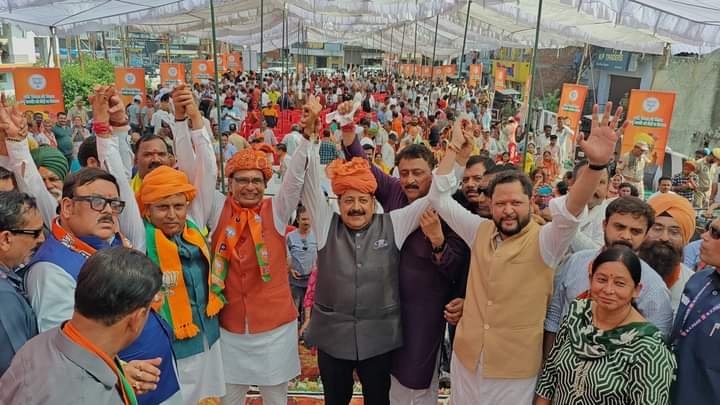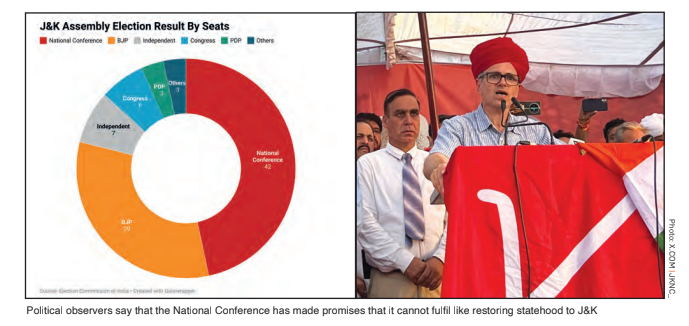
The National Conference might have won a greater chunk of seats in the 90-member Assembly and formed the government, but it’s the BJP that has significantly improved its position to emerge as the second largest party in terms of seat share and highest vote share
In the first Assembly elections in over a decade and, more importantly, the
first following the abrogation of Article 370, Jammu and Kashmir (J&K)
has delivered a split verdict that reflects both regional and religious divisions. The
National Conference (NC) dominated the Muslim-majority Valley, while the Bharatiya Janata Party (BJP) swept the Hindu-majority Jammu region.
The NC emerged victorious with 42 seats in the 90-member Assembly, while
the BJP won 29 seats, all from Jammu. However, in terms of popular vote share,
the BJP emerged the largest party, capturing 25.64% of the votes compared to the
NC’s 23.43%. Overall, the INDIA bloc — comprising
the NC, Congress, and CPI(M) — secured 49 seats. The People’s Democratic Party (PDP) won three seats, the People’s Con
ference got one, and Independents captured seven. Though the BJP failed to secure any seats in the Kashmir Valley, it has made notable progress in terms of popular vote
share. In 2014, the BJP contested 33 constituencies across the Valley and lost in all. This time, it contested only 19 seats but improved its vote share from 2.5% to 5.8% in the Valley. In Gurez constituency, located near the Line of Control, BJP candidate Faqeer Mohammad Khan secured 40% of the vote, narrowly losing to the NC’s Nazir
Ahmad Khan by just 1,000 votes.
Muslim Voter Shift In Jammu Areas
In a surprising development, some Muslim-majority constituencies in Jammu
showed increased support for the BJP. In areas like Thanamandi, Mendhar, and Surankote, the party made significant inroads
among Pahari Muslim voters. This shift
has raised eyebrows among political analysts, highlighting a growing base of support for the BJP in predominantly Muslim
areas as well.
However, several key factors shaped
the electoral outcome against the BJP. An
anti-BJP campaign driven by some religious organisations effectively shaped a
negative narrative against the party. Additionally, the Gujjar community consolidated its votes against the BJP, rallying around
non-BJP candidates. This mobilisation often took on a religious character, aiming to
defeat BJP candidates, while sidelining the
Pahari cause. The opposition successfully
presented a united front that resonated
with voters in these communities, reinforcing historical alliances against the BJP.
Political analysts have hailed the BJP’s
rise as the second largest party in Jammu

and Kashmir as a major achievement. The party increased its vote share from 22% in 2014 to over 25% in 2024 and raised its seat tally from 25 to 29. Despite losing all the seats it contested in the Kashmir Valley, the BJP’s performance in Jammu solidified its standing as a formidable force in the region.
“While the NC may have succeeded in forming the government, the BJP has not
lost. In fact, this is a victory for the BJP. They increased their seat count and vote
share, despite the revocation of Jammu and Kashmir’s special status and its bifurcation into a Union Territory,” says journalist Tariq Ali Mir, a long-time observer of J&K politics. “For the first time, the BJP will serve as the main opposition party in the J&K Assembly, holding power
without responsibility.”
From Taboo To Triumph
The BJP leadership has expressed satisfaction with the election results. Dr Jitendra Singh, Union Minister for Science and
Technology, speaking at a media conclave, emphasised the party’s rise in J&K, saying, “From being a ‘taboo,’ the BJP has now
emerged with the highest vote share in Jammu and Kashmir — a testament to our incredible journey.”
Political analysts say that the losses suffered by Mehbooba Mufti’s PDP and
Engineer Rashid’s AIP is an indicator that
people in the Valley have rejected their ideologies, which are closely aligned with separatist views. However, the NC’s success
in the Valley is being attributed to its misleading and unattainable promises regarding restoration of Article 370, the release
of political prisoners, and a revival of dialogue with Pakistan. The fact is that these promises remain largely beyond the party’s
control, as they fall under the jurisdiction of the Central government.
The BJP, on the other hand, focused on a development-oriented manifesto, pledging prosperity for J&K. Key promises included Rs 10,000 support for farmers under the PM Kisan Samman Nidhi, a 50% reduction in electricity rates for agriculture, and the creation of five lakh jobs for
youth through transparent recruitment processes. The party also proposed travel
allowances for college students under the
Pragati Shiksha Yojana, aiming to ease financial burdens. The 2024 Jammu & Kashmir Assembly elections underscored the region’s deep-rooted regional and religious divides. Though the NC has formed the government, it faces an uphill battle in delivering on its political promises. For the BJP,
this election marks a significant milestone,
positioning the party as a powerful opposition force, with increasing influence and voter support across both Jammu and, to a
lesser extent, the Valley.


Add Comment